 Sketch of Moreton Bay penal settlement, 1835 - item 1
Sketch of Moreton Bay penal settlement, 1835 - item 1
TLF ID R8608
This detailed pencil sketch, attributed to Henry Boucher Bowerman, depicts Moreton Bay (Brisbane) penal settlement from present-day Kangaroo Point. The panoramic landscape view takes in the Brisbane River in the foreground and existing government buildings necessary to a convict settlement, spread across the land behind. The buildings, some of stone and others slab huts, are interspersed with fields, farm buildings, vegetable gardens and narrow dirt roads.
